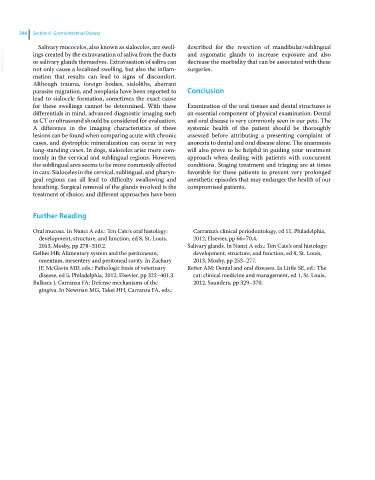Page 578 - Clinical Small Animal Internal Medicine
P. 578
546 Section 6 Gastrointestinal Disease
Salivary mucoceles, also known as sialoceles, are swell described for the resection of mandibular/sublingual
VetBooks.ir ings created by the extravasation of saliva from the ducts and zygomatic glands to increase exposure and also
decrease the morbidity that can be associated with these
or salivary glands themselves. Extravasation of saliva can
not only cause a localized swelling, but also the inflam
mation that results can lead to signs of discomfort. surgeries.
Although trauma, foreign bodies, sialoliths, aberrant
parasite migration, and neoplasia have been reported to Conclusion
lead to sialocele formation, sometimes the exact cause
for these swellings cannot be determined. With these Examination of the oral tissues and dental structures is
differentials in mind, advanced diagnostic imaging such an essential component of physical examination. Dental
as CT or ultrasound should be considered for evaluation. and oral disease is very commonly seen in our pets. The
A difference in the imaging characteristics of these systemic health of the patient should be thoroughly
lesions can be found when comparing acute with chronic assessed before attributing a presenting complaint of
cases, and dystrophic mineralization can occur in very anorexia to dental and oral disease alone. The anamnesis
long‐standing cases. In dogs, sialoceles arise more com will also prove to be helpful in guiding your treatment
monly in the cervical and sublingual regions. However, approach when dealing with patients with concurrent
the sublingual area seems to be more commonly affected conditions. Staging treatment and triaging are at times
in cats. Sialoceles in the cervical, sublingual, and pharyn favorable for these patients to prevent very prolonged
geal regions can all lead to difficulty swallowing and anesthetic episodes that may endanger the health of our
breathing. Surgical removal of the glands involved is the compromised patients.
treatment of choice, and different approaches have been
Further Reading
Oral mucosa. In Nanci A eds.: Ten Cate’s oral histology: Carranza’s clinical periodontology, ed 11, Philadelphia,
development, structure, and function, ed 8, St. Louis, 2012, Elsevier, pp 66–70.4.
2013, Mosby, pp 278–310.2. Salivary glands. In Nanci A eds.: Ten Cate’s oral histology:
Gelber HB: Alimentary system and the peritoneum, development, structure, and function, ed 8, St. Louis,
omentum, mesentery and peritoneal cavity. In Zachary 2013, Mosby, pp 253–277.
JF, McGavin MD, eds.: Pathologic basis of veterinary Reiter AM: Dental and oral diseases. In Little SE, ed.: The
disease, ed 5, Philadelphia, 2012, Elsevier, pp 322–401.3. cat: clinical medicine and management, ed 1, St. Louis,
Bulkacz J, Carranza FA: Defense mechanisms of the 2012, Saunders, pp 329–370.
gingiva. In Newman MG, Takei HH, Carranza FA, eds.:

